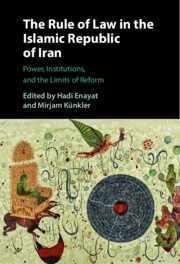Book contents
- The Rule of Law in the Islamic Republic of Iran
- The Rule of Law in the Islamic Republic of Iran
- Copyright page
- Contents
- Figures, Maps and Tables
- Contributors
- Acknowledgments
- Note on Transliteration
- Chronology
- Abbreviations and Glossary
- 1 Governing the Law in the Islamic Republic of Iran
- 2 The Islamic Penal Code of 2013
- 3 The Administration of Criminal Justice in Iran
- 4 Shiʿi Family Law under the Rule of Law? The Iranian Model and Current Approaches in the Shiʿi World
- 5 Rule of Law or Rule by Law? Iran’s Bar Association as a Pawn in Islamic–Republican Contestations
- 6 Law Enforcement and the Judiciary in Postrevolutionary Iran
- 7 The Problem of Overcrowded Prisons in the Islamic Republic of Iran
- 8 Legal Barriers to Accessing Vital Medical Services and Creative Responses to Overcoming These
- 9 Reform from Within? Hākemiyat-e Qānun from the Reformist Era to 2022
- 10 Iran’s Religious and Ethnic Minorities in the Eyes of the Judiciary and the Security Apparatus
- 11 Labor Rights in Postrevolutionary Iran
- 12 The Effects of the Joint Comprehensive Plan of Action (JCPOA), and Subsequent US Withdrawal, on Iranian Law
- 13 Multilayered Mechanisms of Control and Censorship of Arts and Culture in the Islamic Republic of Iran
- 14 The Legal Situation Regarding Assisted Reproduction in Iran
- 15 Conclusions
- Index
- References
2 - The Islamic Penal Code of 2013
Traditions and Innovations*
Published online by Cambridge University Press: 10 April 2025
- The Rule of Law in the Islamic Republic of Iran
- The Rule of Law in the Islamic Republic of Iran
- Copyright page
- Contents
- Figures, Maps and Tables
- Contributors
- Acknowledgments
- Note on Transliteration
- Chronology
- Abbreviations and Glossary
- 1 Governing the Law in the Islamic Republic of Iran
- 2 The Islamic Penal Code of 2013
- 3 The Administration of Criminal Justice in Iran
- 4 Shiʿi Family Law under the Rule of Law? The Iranian Model and Current Approaches in the Shiʿi World
- 5 Rule of Law or Rule by Law? Iran’s Bar Association as a Pawn in Islamic–Republican Contestations
- 6 Law Enforcement and the Judiciary in Postrevolutionary Iran
- 7 The Problem of Overcrowded Prisons in the Islamic Republic of Iran
- 8 Legal Barriers to Accessing Vital Medical Services and Creative Responses to Overcoming These
- 9 Reform from Within? Hākemiyat-e Qānun from the Reformist Era to 2022
- 10 Iran’s Religious and Ethnic Minorities in the Eyes of the Judiciary and the Security Apparatus
- 11 Labor Rights in Postrevolutionary Iran
- 12 The Effects of the Joint Comprehensive Plan of Action (JCPOA), and Subsequent US Withdrawal, on Iranian Law
- 13 Multilayered Mechanisms of Control and Censorship of Arts and Culture in the Islamic Republic of Iran
- 14 The Legal Situation Regarding Assisted Reproduction in Iran
- 15 Conclusions
- Index
- References
Summary
In summer 2013, a new Penal Code came into force in Iran, the first permanent one of its kind, as all previous reforms had been temporary measures. This chapter analyzes some characteristic features of the new 2013 code, particularly with regard to their sources and their effects. While rules in the areas of hadd, qesās, and diyeh are regarded as divine law that cannot be altered or abolished, they have been subject to interpretation, and Iranian Islamic legal scholars often restrict the applicability of hadd, partly by relying on minority opinions in legal justification. Furthermore, the 2013 Penal Code embeds hadd, qesās, and diyeh in other rules of substantive or procedural law in such a way that punishments can be diminished while formally remaining true to Islamic legal traditions. This is done, for example, concerning criminal responsibility of juveniles, and in the law of evidence. The chapter reviews the many adjustments and reforms undertaken in the Islamic Republic’s history to thoroughly Islamize its criminal law.
Keywords
- Type
- Chapter
- Information
- The Rule of Law in the Islamic Republic of IranPower, Institutions, and the Limits of Reform, pp. 45 - 65Publisher: Cambridge University PressPrint publication year: 2025

